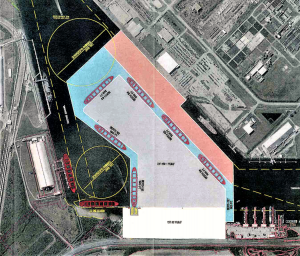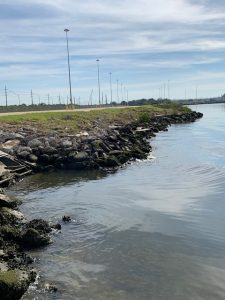While plans for a 63-acre dredge-and-fill project at Port Tampa Bay (PTB) are not yet finalized, bay managers are questioning its viability in terms of both immediate impacts and long-term sustainability.
 If built as proposed, the expansion would include more than a mile of hardened bulkhead with seven berths where oceangoing vessels can dock to load or unload cargo. It also calls for 15 to 17 acres of uplands for each berth although some managers question the need for that much waterfront storage.
If built as proposed, the expansion would include more than a mile of hardened bulkhead with seven berths where oceangoing vessels can dock to load or unload cargo. It also calls for 15 to 17 acres of uplands for each berth although some managers question the need for that much waterfront storage.
The port, with a regional economic impact of $17 billion in 2015, constructs a new berth about every other year. The proposed 63 acres would support that growth for 10 to 15 years, said Patrick Blair, the port’s director of engineering.
The expansion is unprecedented in recent times, particularly considering that PTB recently received approval to fill 24 acres for their most recently completed berths, writes Christina Bryant, senior environmental manager for the Environmental Protection Commission of Hillsborough County.
The proposed site at East Bay, just south of Causeway Boulevard and east of the shrimp docks, was once a thriving estuarine ecosystem with shallow bottoms and seagrasses. That changed in the 1920s when it was dredged to build Causeway Boulevard and dredged again in the 1960s to fill the nearby railyard.
The Army Corps of Engineers, which holds the final responsibility for approving or denying the permit, notes that the proposed project could adversely affect habitats for multiple endangered or threatened species, including manatees and smalltooth sawfish, as well as loggerhead, Kemp’s ridley and green sea turtles. This open water area is also considered essential fish habitat for a number of fish species, and filling it in would limit access to Tampa Bay from McKay Bay and the Palm River.

Bay managers also questioned the use of a former dump for the city’s incinerator as a mitigation site, but PTB is actively searching for other alternatives, said Chris Cooley, director of environmental affairs. “We’ve reached out to SWIM (Southwest Florida Water Management District’s Surface Water Improvement and Management program) and ELAPP (Hillsborough County’s Environmental Lands Acquisition and Protection Program) – we’ve worked with them before, and still have some (mitigation) credits left over.”
Along with the immediate environmental impacts, Hillsborough County Commissioner Mariella Smith questioned the long-term when the port will reach its full potential. “What is the long-range plan,” she asked. “When does this end?”
Her rhetorical question was not answered but the expansion has been on the port’s master plan since 2008, Cooley said. “We’re required by state statute to update our master plan for the next 20 years every five years. The need is there – even today everything you buy from Walmart or Amazon is shipped to Miami or Savannah and then gets here by truck. That costs consumers more and raises its carbon footprint.”
